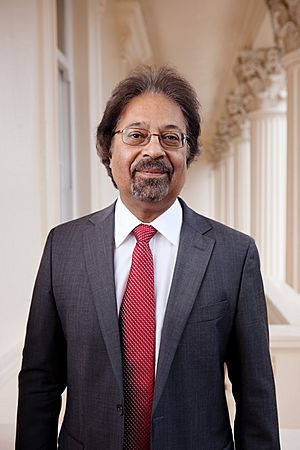Tejinder Virdee facts for kids
Quick facts for kids
Tejinder (Jim) Virdee
|
|
|---|---|

Tejinder Virdee on the balcony of the Royal Society in July, 2012
|
|
| Born |
Tejinder Singh Virdee
13 October 1952 Nyeri, Kenya Colony
|
| Nationality | British |
| Alma mater | Queen Mary College, University of London (B.Sc.) Imperial College London (Ph.D.) |
| Known for | Originating the concept and overseeing the construction of CMS |
| Awards | IOP Chadwick Medal and Prize (2009) Special Breakthrough Prize in Fundamental Physics (2013) EPS HEPP Prize (2013) IOP Knight Bachelor (2014) Glazebrook Medal (2015) APS Panofsky Prize (2017) Royal Medal (2024) |
| Scientific career | |
| Fields | Physics (particle physics) |
| Institutions | Imperial College London |
| Thesis | Sigma Hyperon Production in a Triggered Bubble Chamber (1979) |
| Doctoral advisor | Peter Dornan FRS |
Sir Tejinder Singh Virdee (born 13 October 1952) is a British scientist who studies tiny particles. He was born in Kenya. He is a Professor of Physics at Imperial College London.
Sir Tejinder is famous for helping to create the Compact Muon Solenoid (CMS). This is a giant science experiment. It is part of the Large Hadron Collider (LHC) at CERN in Switzerland. CMS helped discover a special particle called the Higgs boson. Many scientists from all over the world work together on CMS.
Because of his important work, Sir Tejinder has won many awards. In 2014, he was made a Knight by the Queen for his services to science.
Early Life and Learning
Tejinder Virdee was born in 1952 in Nyeri, Kenya. His parents were Udham Kaur and Chain Singh Virdee. He went to school in Kisumu, Kenya. In 1967, his family moved to Birmingham, England, because of difficult times in Kenya.
He says his physics teacher, Howard Stockley, helped him love science. He also remembers visiting a science museum. There, he saw a "cloud chamber." This made him very interested in how matter is made. He earned his first degree in Physics from Queen Mary College, University of London in 1974.
His Science Work
After finishing his advanced studies at Imperial College London, Tejinder Virdee joined CERN in 1979. CERN is a big science lab in Europe.
Early in his career, he helped prove that tiny particles called "quarks" have a special electric charge. Quarks are the building blocks of things like protons and neutrons. Later, he worked on an experiment called UA1. Here, he learned how to build special detectors. These detectors measure the energy of particles.
Around 1990, Sir Tejinder and other scientists started planning a new experiment. They wanted to find missing parts of the Standard Model. The Standard Model is like a rulebook for how particles work. This new experiment became the Compact Muon Solenoid (CMS). It is one of the most complex science tools ever built.
Since 1991, Sir Tejinder has been a key part of CMS. He helped design, build, and set up the detector. He also helped collect and understand the data. He made important choices about the technology used in CMS. For example, he helped choose the special materials for the part of CMS that measures particle energy.
Finding the Higgs boson was a big goal for CMS. In 1992, Sir Tejinder strongly supported the CMS design. CERN chose CMS as one of two main experiments for the Large Hadron Collider.
He also studied how the Higgs boson might be found. He showed that special crystals could help detect it. These crystals were used in CMS. In July 2012, CMS found strong evidence for the Higgs boson. Sir Tejinder was deeply involved in looking at the data for this discovery.
Sir Tejinder was a leader for the CMS project for many years. He helped oversee the final building and setup of CMS. He also helped when the LHC started running and collecting data.
He also works to support science and education. He helps fund science activities in schools and universities. This includes places in Africa, India, and the United Kingdom.
Talks and Sharing Science
Sir Tejinder has given many talks at science meetings. He has also given public lectures about the LHC project. He has shared his knowledge with many people.
He has also been interviewed on radio shows. This includes a talk with Jim Al-Khalili on the BBC Radio 4 program "The Life Scientific."
Awards and Honors
- 2024: Awarded the Royal Medal by the Royal Society.
- 2020: Awarded the Blaise Pascal Medal in Physics.
- 2018: Received an honorary Doctor of Science degree from Panjab University, India.
- 2017: Awarded the Panofsky Prize by the American Physical Society.
- 2015: Awarded the Institute of Physics Richard Glazebrook Medal and Prize.
- 2013: Awarded the European Physical Society High Energy Physics Prize.
- 2013: Received honorary Doctor of Science degrees from the University of Lyon and Queen Mary University of London.
- 2012: Awarded the Special Breakthrough Prize in Fundamental Physics.
- 2009: Awarded the Institute of Physics James Chadwick Medal and Prize.
- 2007: Awarded the European Physical Society High Energy and Particle Physics Prize.

